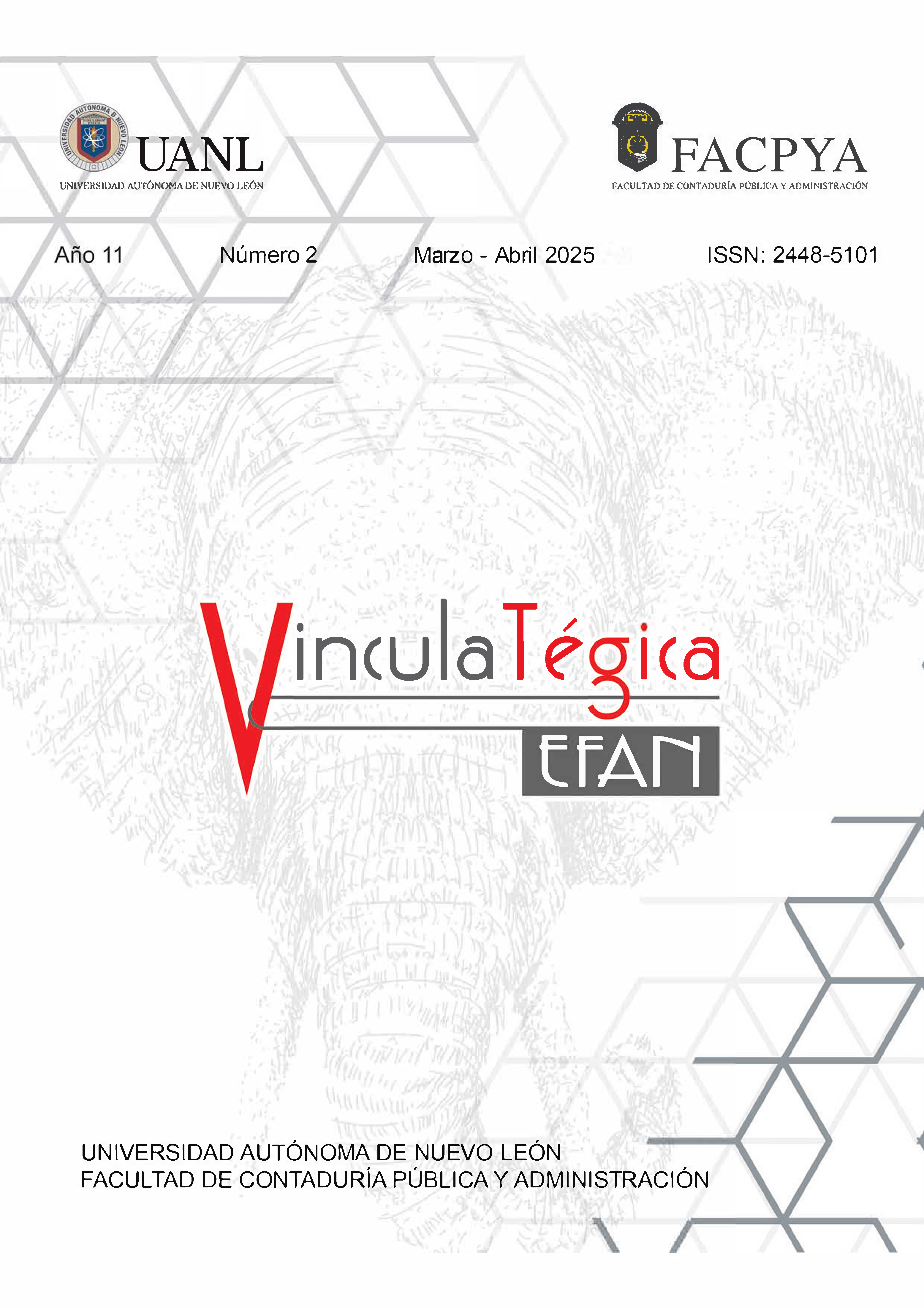Percepción de los Estudiantes de Ingeniería Industrial de la UANL sobre la Inteligencia Artificial en la Educación Superior
DOI:
https://doi.org/10.29105/vtga11.2-1025Palabras clave:
Educación, Ingeniería industrial, Inteligencia ArtificialResumen
La Inteligencia Artificial (IA) es uno de los pilares tecnológicos de la Transformación Digital. Esta nueva tecnología se aplica en variadas áreas, entre ellas, la educación superior. El objetivo de esta investigación es conocer la percepción de los estudiantes de 9no. y 10mo. semestre de la licenciatura Ingeniería Industrial y Administración de la UANL con respecto a la enseñanza y aplicación de la IA en la educación superior. Primero se realizó una amplia exploración documental del tema. Posteriormente se realizó un estudio mixto (cuantitativo y cualitativo), exploratorio, con diseño no experimental y transaccional. Se diseñaron dos instrumentos de medición, un cuestionario y un guion de entrevista semiestructurada con la finalidad de conocer la opinión de los estudiantes sobre la IA. Se obtuvieron 64 muestras aplicadas del cuestionario y 3 entrevistas. Los resultados indican que 38% de los encuestados considera que sabe muy poco de la IA, sin embargo, el 44% considera que es un tema indispensable en su educación universitaria. Así mismo, los estudiantes perciben ventajas de alto valor en la aplicación de la IA en la educación, tales como mayor eficiencia en la enseñanza y muestran un alto interés por aprender más acerca de la IA.
Descargas
Citas
ABET Engineering Accreditation Commission. (2018). Criteria for accrediting engineering programs, effective for reviews during the 2019–2020 accreditation cycle. USA: ABET Engineering Accreditation Commission. https://www.abet.org/
Aparicio Gómez, W. O. (2023). La Inteligencia Artificial y su Incidencia en la Educación: Transformando el Aprendizaje para el Siglo XXI. Revista Internacional De Pedagogía E Innovación Educativa, 3(2), 217–229. https://doi.org/10.51660/ripie.v3i2.133 DOI: https://doi.org/10.51660/ripie.v3i2.133
Basco, A. I., Beliz, G., Coatz, D., Garnero, O., & Garnero, P. (2018). Industria 4.0 Fabricando el Futuro. Banco Interamericano de Desarrollo (BID). http://dx.doi.org/10.18235/0001229 DOI: https://doi.org/10.18235/0001229
Creswell, J. W. (2017). Research design: Qualitative, quantitative, and mixed methods approaches (5th ed.). Sage.
Chiu, T. K., Xia, Q., Zhou, X., Chai, C. S., & Cheng, M. (2023). Systematic literature review on opportunities, challenges, and future research recommendations of artificial intelligence in education. Computers and Education: Artificial Intelligence, 4, 100118. https://doi.org/10.1016/j.caeai.2022.100118 DOI: https://doi.org/10.1016/j.caeai.2022.100118
Deshpande, D. S., Shanmugapriya, I., Choudhary, R. K., Patil, S. S., Singh, A., & Lotlikar, S. (2023) An Empirical Study on the Impact of Artificial Intelligence in Education with Reference to Teaching and Learning https://www.researchgate.net/profile/Dr-Dhananjay-Deshpande-2/publication/378861417_Regular_Issue_1/links/65ee9f66b7819b433bf539da/Regular-Issue-1.pdf
Garrell, A., & Guilera, L. (2019). La industria 4.0 en la sociedad digital. Marge Books.
González Palomo, I. G., Solís Peña, C., & García León, A. M. (2022). Análisis a Cursos en Línea para el Programa de Ingeniero Industrial Administrador con Tecnologías Digitales. Vinculatégica EFAN, 8(6), 1–11. https://doi.org/10.29105/vtga8.6-357 DOI: https://doi.org/10.29105/vtga8.6-357
González Sánchez, J. L., Villota Garcia, F. R., Moscoso Parra, A. E., Garces Calva, S. W., & Bazurto Arévalo, B. M. (2023). Aplicación de la Inteligencia Artificial en la Educación Superior. Dominio De Las Ciencias, 9(3), 1097–1108. https://doi.org/10.23857/dc.v9i3.3488
González-González, C. S. (2023). El impacto de la inteligencia artificial en la educación: transformación de la forma de enseñar y de aprender. Qurriculum, 36, 51–60. https://doi.org/10.25145/j.qurricul.2023.36.03 DOI: https://doi.org/10.25145/j.qurricul.2023.36.03
Hwang, G. J., Xie, H., Wah, B. W., & Gašević, D. (2020). Vision, challenges, roles and research issues of Artificial Intelligence in Education. Computers and Education: Artificial Intelligence, 1, 100001. https://doi.org/10.1016/j.caeai.2020.100001 DOI: https://doi.org/10.1016/j.caeai.2020.100001
Idroes, G. M., Noviandy, T. R., Maulana, A., Irvanizam, I., Jalil, Z., Lensoni, L., Lala, A., Abas, A. H., Tallei, T. E., & Idroes, R. (2023). Student Perspectives on the Role of Artificial Intelligence in Education: A Survey-Based Analysis. Journal of Educational Management and Learning, 1(1), 8–15. https://doi.org/10.60084/jeml.v1i1.58 DOI: https://doi.org/10.60084/jeml.v1i1.58
Khosravi, H., Shum, S. B., Chen, G., Conati, C., Tsai, Y. S., Kay, J. & Gašević, D. (2022). Explainable artificial intelligence in education. Computers and Education: Artificial Intelligence, 3, 100074. https://doi.org/10.1016/j.caeai.2022.100074 DOI: https://doi.org/10.1016/j.caeai.2022.100074
Macías Lara, R. A., Solorzano Criollo, L. R., Choez Calderón, C. J., & Blandón Matamba, B. E. (2023). La inteligencia artificial; análisis del presente y futuro en la educación superior.: Artificial intelligence; analysis of the present and future in higher education. Revista Científica MultidisciplinarG-Nerando, 4(1). https://revista.gnerando.org/revista/index.php/RCMG/article/view/98
Montgomery, D. C., & Runger, G. C. (2007). Probabilidad y estadística aplicadas a la ingeniería. Limusa Wiley.
Nagao, K. (2019). Artificial Intelligence in Education. Artificial Intelligence Accelerates Human Learning, 1–17. https://doi.org/10.1007/978-981-13-6175-3_1 DOI: https://doi.org/10.1007/978-981-13-6175-3_1
Ouyang, F., & Jiao, P. (2021). Artificial intelligence in education: The three paradigms. Computers and Education: Artificial Intelligence, 2, 100020. https://doi.org/10.1016/j.caeai.2021.100020 DOI: https://doi.org/10.1016/j.caeai.2021.100020
Pisica, A.I.; Edu, T.; Zaharia, R.M.; Zaharia, R. (2023) Implementing Artificial Intelligence in Higher Education: Pros and Cons from the Perspectives of Academics. Societies 2023, 13, 118. https://doi.org/10.3390/soc13050118 DOI: https://doi.org/10.3390/soc13050118
Rouhiainen, L. (2018). Inteligencia artificial. Madrid: Alienta Editorial.
Shenton, A. K., Neilson, D., & Birley, M. (2013). A mixed methods systematic review of published qualitative and quantitative studies on the impact of the COVID-19 pandemic on physical activity and sedentary behavior. International Journal of Behavioral Nutrition and Physical Activity, 10(1), 142.
Ulloa-Duque, G. S., Torres -Mansur, S. M., & López-Piñón, D. C. (2020). Industria 4.0 en la educación superior. Vinculatégica EFAN, 6(2), 1348–1357. https://doi.org/10.29105/vtga6.2-585 DOI: https://doi.org/10.29105/vtga6.2-585
Vera, F. (2023). Integración de la Inteligencia Artificial en la Educación superior: Desafíos y oportunidades. Transformar, 4(1),17–34. https://www.revistatransformar.cl/index.php/transformar/article/view/84
Zouhaier, S. (2023). The Impact of Artificial Intelligence on Higher Education: An Empirical Study. European Journal of Educational Sciences, 10(1), 17-33. http://dx.doi.org/10.19044/ejes.v10no1a17 DOI: https://doi.org/10.19044/ejes.v10no1a17
Descargas
Publicado
Cómo citar
Número
Sección
Licencia
Derechos de autor 2024 Elva Patricia Puente Aguilar, Dra. María de los Angeles Martínez Mercado, Dr. Leonardo Gabriel Hernández Landa

Esta obra está bajo una licencia internacional Creative Commons Atribución 4.0.
Los autores que publiquen en la revista VinculaTégica EFAN aceptan el siguiente aviso de derechos de autor:
a). Los autores conservan los derechos de autor y ceden a la revista el derecho de la primera publicación de la obra bajo una licencia de atribución de Creative Commons. Esta licencia permite a otros compartir la obra siempre que se reconozca la autoría original y la publicación inicial en esta revista.
b). Los autores pueden establecer acuerdos contractuales adicionales de manera independiente para la distribución no exclusiva de la versión publicada en la revista (por ejemplo, publicarla en un repositorio o incluirla en un libro), siempre que se reconozca la publicación inicial en esta revista.
c). Se permite a los autores autoarchivar su trabajo en repositorios institucionales o en su propio sitio web antes y durante el proceso de envío, ya que esto puede fomentar intercambios productivos y aumentar la citación temprana y general del trabajo publicado.







